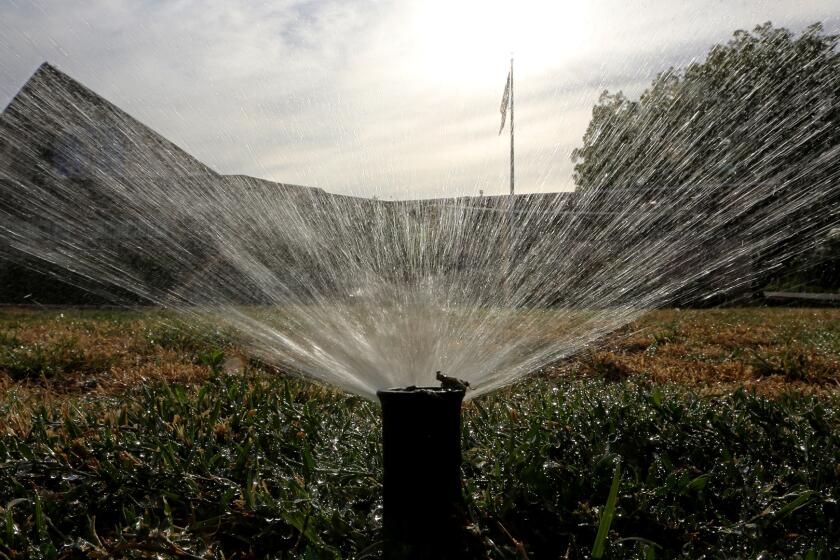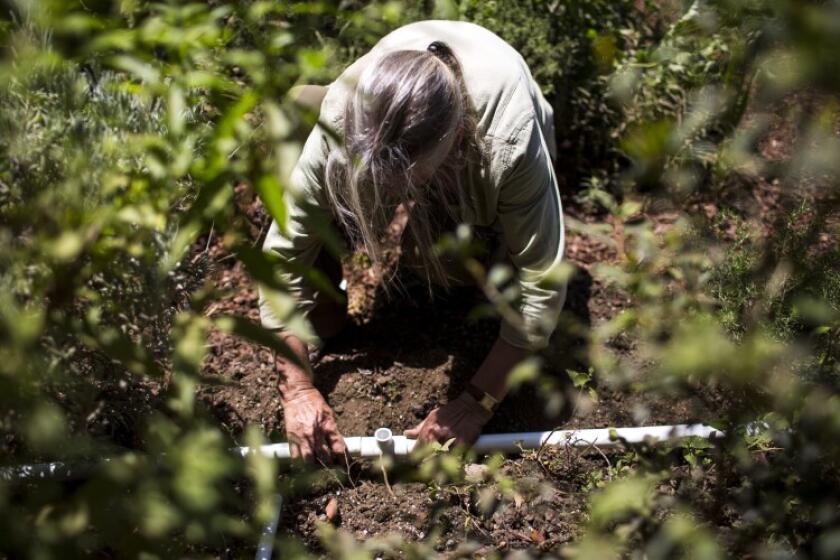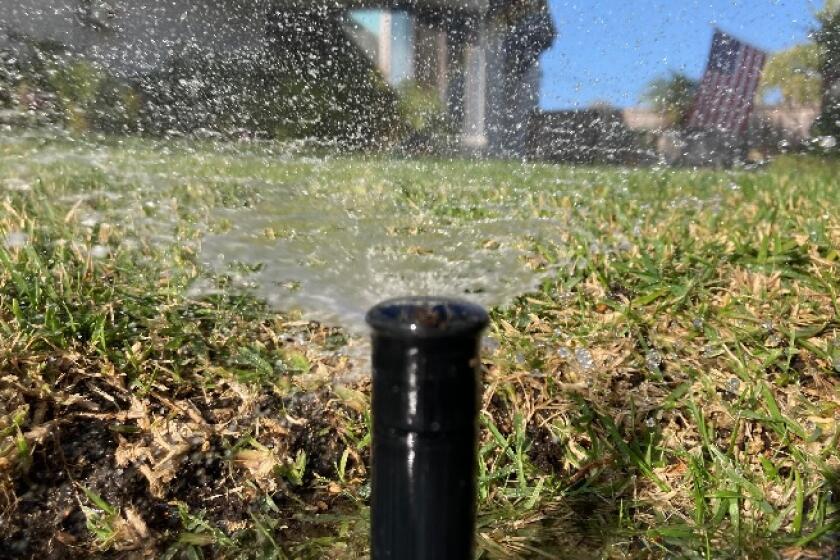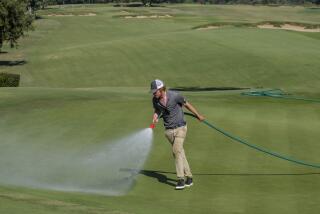To pre-rinse or not to pre-rinse? How to use your dishwasher during the drought
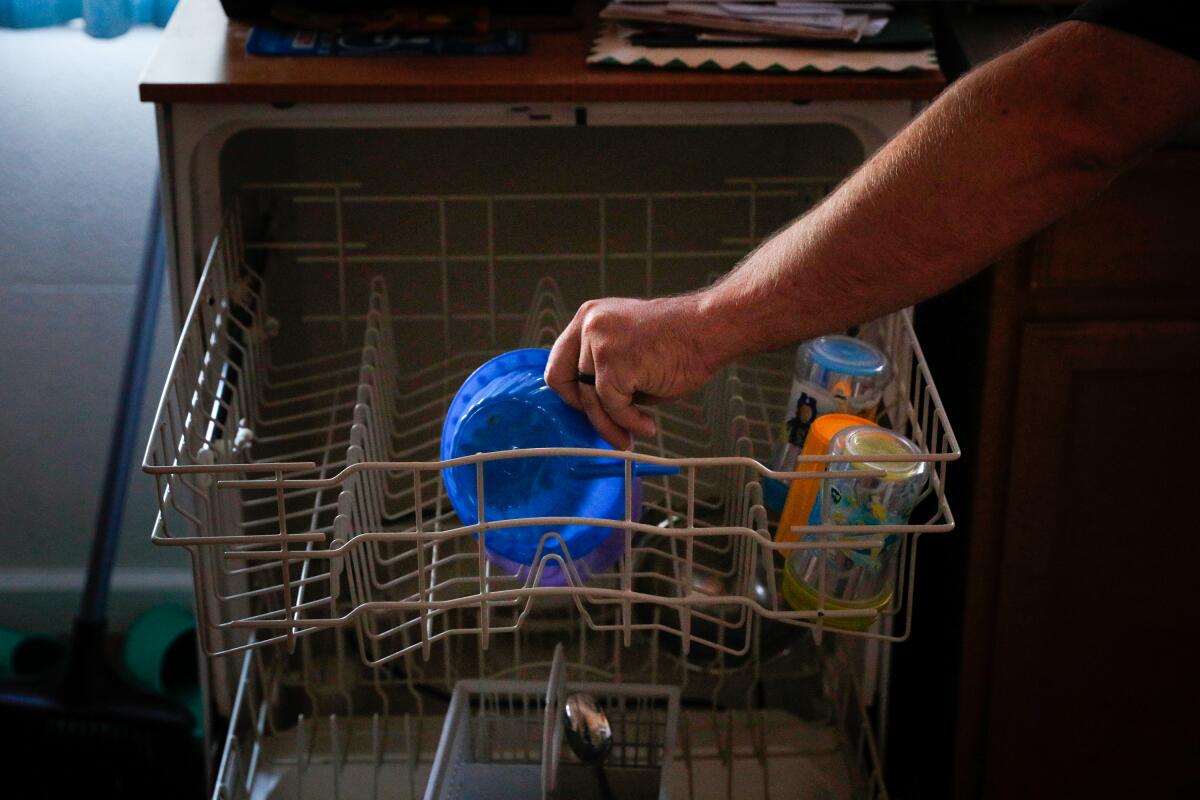
The science is in. Dishwashers save water — especially if you run them only when you have a full load.
Experts will also tell you that you don’t even need to pre-rinse the crusty, sticky residue off your dishes before depositing them in the dishwasher. Just scrape the solid food off.
That saves even more water.
But for some who grew up not having a dishwasher, using the dishwasher mainly as a dish rack, or pre-rinsing the dishes before putting them in the machine (a ritual of up to 80% of dishwasher owners, estimated Wirecutter), ingrained dish-washing habits die hard.
A Los Angeles Department of Water and Power study in 2013-14 found that only 60% of single-family homes in L.A. had a dishwasher — less than the national average — and only about 32% of multifamily homes had one. A nationwide U.S. Energy Information Administration survey showed that in 2020, 72% of homes owned a dishwasher but about 20% of dishwasher owners never used theirs.
“It’s all very emotional, right?” said Liam McCabe, who is a longtime home and appliances reporter. He wrote the Wirecutter “How to Use Your Dishwasher Better” explainer and currently works for Consumer Reports, where he just anointed the Best Dishwashers of 2022.
“There is research that points to certain things in terms of appliance use, and then there’s the reality of what actually happens in people’s homes — how comfortable they are with it,” he said. But the facts, he added, make it hard not to conclude that “a dishwasher will save you a ton of water.”
The Metropolitan Water District of Southern California recently declared a water shortage emergency and announced strict water restrictions for about 6 million residents, starting June 1. The goal is to achieve a 35% reduction in water consumption, or a limit of 80 gallons per person per day on average.
Though the restrictions target outdoor watering, Californians may want to take this warning as an opportunity to be more mindful about conserving water in general. Whether you’re a seasoned dishwasher user or a newbie treading into uncharted territory, here are the basics of how to use a dishwasher most efficiently.
Californians are well-acquainted with the need to save water. Here are some practical tips to cut your water use, plus a look at the big picture.
How do dishwashers save water?
A 2016 global dishwashing study showed that Americans use 42.3 gallons of water on average while hand washing the equivalent of a full dishwasher load of dishes.
In comparison, dishwashers manufactured after 2013 use less than five gallons per normal cycle because they’re required by energy conservation standards to meet that limit. Energy Star-certified dishwashers use less than 3.5 gallons.
Some people might assume that you need a modern, expensive dishwasher to have all the conservation benefits, but even the older models dating back to the ‘90s use only about 10 to 15 gallons a load.
“The thing that throws people off is that over time, the cycle times have gotten longer and longer,” said McCabe. “It’s kind of counterintuitive.”
But the reason they need to run longer has nothing to do with the amount of water that’s being used. It’s to keep up with the energy efficiency standards, he said.
Here’s another way to think about the water it takes to wash dishes: A sink faucet uses about 2.5 gallons of water a minute. So in order to use less water than a dishwasher that’s been purchased in the last decade, you’d have to scrub and rinse an entire dishwasher load of dishes with less than two minutes of running water.
That said, not all hand-dishwashing is the same. The two-basin method, where dishes are scrubbed and soaped in one basin of water and then rinsed in a second basin, is a water-efficient way to clean dishes without a dishwasher, and it uses less energy. But it can still use more water than an Energy Star dishwasher, especially if you need to replace some of the water in the rinsing basin after it gets too sudsy.
The water that cleans your clothes isn’t safe to drink, but it could be good for your plants. Here’s how to use grey water amid drought restrictions.
Can you really skip pre-rinsing the dishes?
In the past, McCabe has taken a hard line against pre-rinsing, going so far as to say that he found it baffling that people are so skeptical and stubborn about this. He’s not alone. Experts have been trying to tell the general public for more than three decades to just scrape the food off the plate before putting it into the dishwasher.
“Every dishwasher company, detergent company, and independent expert we’ve talked to says that pre-rinsing is unnecessary — as does the Environmental Protection Agency,” McCabe wrote last year. “Some of our sources even said you might get better results without pre-rinsing because modern enzymatic detergents work better when they can cling to food. And we’ve confirmed this with our own tests, over and over and over again.”
But he says he’s softened his stance “a little bit” since then.
“Obviously there’s enough cases where it just clearly doesn’t work for people,” he said. “The change for me was that I moved into a new house that had a terrible dishwasher, and nothing I did could get it to work consistently. So that was a little humbling for me to realize that.”
The reality is that you might just have a bad dishwasher. And even the good ones get worn down over time.
That said, many of us do have perfectly capable dishwashers that can get the dried pesto hummus off your plate, catch the chunks in the filters and pulverize any remaining pieces into tiny bits that will flow smoothly down the drain.
McCabe encourages people to try skipping the pre-rinsing. Even if it doesn’t work at first, here are some things you can experiment with that pose little risk but offer a potentially high reward:
- Clean the filters with a sponge. “Food does build up throughout the system over time,” he said. You can also check the holes in the spray arms to make sure they’re not clogged.
- Run the self-cleaning cycle. “They sell dishwasher cleaning tabs at the grocery store, or you can just use citric acid,” he said.
- Try a different (higher-end) detergent. You want a detergent with enzymes (for example, protease, amylase or subtilisin). “In general, the packs and the single-dose tabs work better,” he said. “You can keep experimenting with detergents to see if you can get a better result.”
- Use a rinse aid. “Every manufacturer recommends it and hardly anyone does it, but it does make a difference,” he said.
- Look into a water softener, if applicable. Most of the water in Southern California is considered hard water because it contains relatively high levels of minerals. This can affect the way the detergent does its job, said McCabe. If you can’t tinker with water softener, you might want to try a higher-end detergent, a larger amount of detergent per load or additives made to help with hard water.
- Experiment with different cycles. The normal cycle is the cycle that must meet the energy efficiency standards, and it generally uses the least water. But if it’s not working, try the heavy or turbo mode. Or try the pre-wash, which is the equivalent of adding a tiny scoop of detergent at the bottom of the tub. (Alternately, if it is working, see if it still works when you do it on the light or energy saver mode, so you can save more water and energy.)
“Worst case, you just hand wash the dishes or rinse them again by hand afterward,” he said.
He understands that it’s frustrating if you open up the dishwasher and it hasn’t cleaned all your dishes. But he encourages people to think about your dishwasher situation and water-saving efforts holistically.
“It’s no different than pre-rinsing,” he said. “It’s post-rinsing. It’s the same end result in the same amount of time.”
Southern California officials have declared a water shortage emergency. Here’s how to keep home and garden dreams alive while still restricting water usage.
How to pack the dishwasher
Many dishwasher instruction manuals have specific tips on how to best load your specific dishwasher. There are also YouTube videos where people use a GoPro camera to film inside a dishwasher to show how the sprays are working. Understanding the basics of how the system functions can help you understand how to pack your dishwasher most efficiently.
“It’s a pretty simple system,” McCabe said. “There’s a plastic arm. [The dishwasher] pumps water through it, and the force of the water going through the arm makes it spin. And if they’ve designed it well, the little holes in the arm should point the water in just the right places at the right time so that every part of the rack gets a little bit of water on it during the cycle.”
You want to place your dishes with the dirty surfaces down, angled toward the washer jets. And if you load large items (pots or pans) or tall items (trays or jugs) on the bottom rack, make sure they’re not blocking the wash arms’ ability to spray the other dishes.
McCabe said that you can probably pack it tighter than you think you can, as long as items are separated and water can get through the gaps. You don’t want dishes to knock up against each other.
But you should be strategic about where to put your dirtier dishes, he said.
The dishwasher racks are rectangular, but the wash arms spin in a circle, so the corners of the top rack get the least amount of water.
“A coffee mug with a little bit of a coffee stain on it doesn’t need a lot of attention from the dishwasher to get it clean,” he said. “But if it’s a cup of dried oatmeal and yogurt, that might benefit from being more in the center where it’s getting a more direct blast of water more often during the cycle.”
Some other tips
- In the utensils basket, put in forks and spoons with the handles down, but place knives with their handles up (so you don’t accidentally stab yourself). If you don’t have a cutlery drawer, put them flat on the upper rack. This is where you can also put spatulas, tongs and rice paddles.
- Put your more delicate dishes in the top rack, which gets a gentler wash.
- Plastic should also go on the top rack to keep it from overheating. The dishwasher’s heating elements are on the bottom.
- Silver and stainless steel shouldn’t touch, because the dishwashing process creates a chemical reaction that damages both.
- Silicone is generally dishwasher-safe, so go ahead and put the silicone kitchenware, placemats, sippy cups and that Instant Pot sealing ring in there.
What can’t go in the dishwasher
McCabe said that if it fits, he puts it in the dishwasher — including large pots and pans. But he said that others may be more particular about their dishware and should make decisions on a case-by-case basis.
Why did Californians ignore Gavin Newsom’s water conservation plea? In a drought, conservation messaging needs to be sharper — and even a little terrifying.
Things to keep in mind
- Wood doesn’t do well in the warm, humid environment of a dishwasher. So put your metal and plastic chopsticks in the dishwasher, flat on the top rack unless you have an appropriate basket, and leave your wooden ones out — unless you don’t care if they eventually warp.
- Copper and aluminum pots and pans can get damaged or discolored in the dishwasher. Hand-washing is also usually recommended for non-stick cookware.
- If you seasoned a cast iron skillet, hand-washing is better because a dishwasher (and the detergent) can break down the seasoning.
- If you will be very upset about something breaking (fine china, crystal, your fancy expensive Japanese knives, a treasured souvenir Dodgers cup), don’t put it in the dishwasher.
- And it’s called a dishwasher, so wash only dishes. A supervisor at Repairclinic.com told Consumer Reports that people washing candlesticks in the dishwasher is a common problem. The hot wax softens during the wash cycle, drips into the machine’s crevices and then hardens, potentially destroying your dishwasher. “Anything you see on TikTok that’s like, ‘Check this out. Here’s what you can do with your dishwasher besides washing dishes,” do it at you own risk,” McCabe said. “It’s probably a bad idea.”
When in doubt, check the instruction manual to see if the materials you want to wash are prone to cracking, warping or discoloring.
“The way I look at it is that dishwashers should make your life easier,” he said. “If you follow the steps or at least try to follow the advice about how to get the most out of your dishwasher, it should also save you a ton of time and energy — and a lot of water. So what is there to lose? Why not give it a shot?”
The L.A. Times wants to hear and publish your tips for saving water so everyone can learn from them. Tell us what you’re doing.
